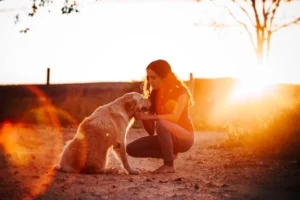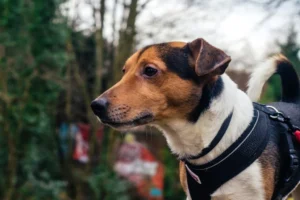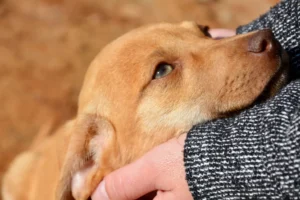Disclosure: We may earn a commission from helpful, relevant links in our content. No cost to you. See our privacy policy.
Absolutely, choosing a coat for your dog can be as tricky as picking one out for yourself. Between materials that don’t breathe, sizes that don’t fit, and styles that just don’t suit, it’s enough to make anyone’s head spin. In this post, you’ll find the nitty-gritty on selecting the perfect coat that keeps your furry friend warm, comfortable, and stylish, without the usual hassle.
Quick Takeaways:
- Measure your dog’s neck, chest, and length for a perfect fit; when in doubt, size up.
- Choose breathable and weather-appropriate materials like fleece for comfort or waterproof fabrics for wet conditions.
- Regular care of the coat, including proper washing, air drying, and Velcro maintenance, extends its life and effectiveness.
Why Material Matters in Dog Coats
Choosing the right material for your furry friend’s coat isn’t just about fashion; it’s about comfort, weather resistance, and safety. A well-chosen fabric can mean the difference between a cozy walk in the park and a shivering pup or, worse, overheating.
-
Comfort : Soft, breathable fabrics like fleece or cotton blends are gentle on your dog’s skin and prevent irritation. They provide warmth without causing your dog to overheat during activity.
-
Weather Resistance : For those wet, windy days, materials like nylon or specialized waterproof fabrics fend off the elements, keeping your pooch dry and snug.
-
Safety : Reflective materials are a lifesaver for night walks. They ensure your dog is visible to drivers, cyclists, and other pedestrians.
An often overlooked gem is Merino wool. Unlike regular wool, Merino is incredibly soft and has temperature-regulating properties, making it a superb choice for dog coats. It keeps your dog warm when it’s cold and breathes when it’s warm, suitable for a range of climates.
How to Measure Your Dog for the Perfect Fit
Getting the perfect fit for your dog’s coat is crucial. A coat that’s too tight restricts movement and can cause discomfort, while a loose one fails to retain heat efficiently and might even pose a safety risk. Here’s how to get it right:
-
Length : Measure from the base of the neck to the base of the tail. This ensures the coat covers the essential body parts without restricting movement.
-
Girth : Measure the widest part around your dog’s chest. This is usually a bit behind the front legs. For a secure fit, add a couple of inches to your measurement.
-
Neck : Measure around the base of your dog’s neck, where the collar sits. Make sure it’s not too snug.
Remember, when in doubt, size up rather than down. Many brands have specific sizing guides, so compare your measurements against them.
Is Waterproofing Necessary?
Whether your dog needs a waterproof coat depends on your climate and lifestyle. If you live in a region with lots of rain or snow, or if your dog loves splashing in puddles during walks, then yes, waterproofing is a must.
Waterproof coats come in various levels of protection:
- Water-resistant: Suitable for light rain but not heavy downpours.
- Water-repellent: Offers a higher level of protection, turning away water more effectively.
- Fully waterproof: These coats provide the best protection against rain and wet conditions, often featuring sealed seams and specialized materials.
A unique insight for dog owners is to consider breathability along with waterproofing. Some waterproof materials can trap heat, causing discomfort. Look for coats that offer waterproof and breathable technology, similar to what’s found in high-quality human outdoor wear. Brands like Ruffwear and Hurtta offer such innovations, ensuring your dog stays dry without overheating.
In conclusion, selecting the right material and fit and deciding on waterproofing are essential steps in choosing the best coat for your dog. It’s not just about keeping them warm; it’s about ensuring their walks are as enjoyable and comfortable as possible, regardless of the weather. With these tips, you’re well on your way to finding the perfect coat for your canine companion. Stay tuned for more insights on keeping your dog happy and healthy.
Can Dog Coats Be Fashionable and Functional?
Absolutely! Gone are the days when dog coats were merely practical without any thought given to aesthetics. Today, the fusion of fashion and functionality is not just a possibility; it’s a reality that savvy canine owners are embracing wholeheartedly.
Materials like Gore-Tex and fleece provide insulation and water resistance, while staying lightweight and stylish. Some coats even feature reflective strips for nighttime safety, cleverly integrated into the design to enhance both the coat’s appeal and utility. Brands are increasingly collaborating with fashion designers to create coats that make a statement, proving that your dog can be just as stylish as you are.
Moreover, customization options have taken dog fashion to new heights. From bespoke fittings to personalized embellishments, dog coats can reflect your pet’s unique personality without compromising on comfort or protection against the elements. For instance, a custom-tailored houndstooth print coat can turn heads at the dog park while keeping your pooch warm and cozy.
Breeds That Benefit Most From Wearing Coats
Not all dogs are created equal when it comes to withstanding cold weather. Here are a few breeds that particularly benefit from an extra layer during those chilly walks:
- Greyhounds and Whippets: These sighthounds have very little body fat and short coats, making them susceptible to the cold.
- Chihuahuas: Tiny but mighty, these little dogs lose body heat quickly and benefit greatly from insulation.
- Senior Dogs: Older dogs, regardless of breed, often struggle to regulate their body temperature and therefore can use the additional warmth.
- Dogs with Medical Conditions: Pets with conditions like arthritis or heart issues may require coats to help maintain a stable body temperature.
Understanding your dog’s specific needs is crucial. For example, a thick-coated Siberian Husky may not require as much additional warmth as a shorthaired Dachshund in the same environment. Always observe your pet’s behavior in cold weather to guide your decisions about when a coat is necessary.
Caring for Your Dog’s Coat
To ensure your dog’s coat remains both efficient and stylish, proper care is essential. Here’s how to keep it in top shape:
- Washing: Always follow the care label. Many dog coats can be machine washed on a gentle cycle, but some might require hand washing to avoid damage.
- Drying: Never put a dog coat in the dryer unless the care instructions explicitly say it’s safe. Instead, air drying is preferred. Lay the coat flat in a well-ventilated area out of direct sunlight to prevent shrinkage and fading.
- Storage: During the warmer months, store the coat in a cool, dry place. Consider using a garment bag to protect it from dust and pests.
One highly specific tip that’s often overlooked: Velcro care. Velcro fasteners can gather hair and debris, losing their efficacy. Clean the Velcro regularly by gently picking out hair and snipping away any threads. This simple step ensures the coat remains secure and neat, an easy but game-changing practice not all dog owners are aware of.
A well-chosen, diligently cared-for dog coat is more than just a garment. It’s a statement of your love and commitment to your pet’s well-being, ensuring they’re as comfortable as possible, no matter what the weather brings. By considering both fashion and function, along with proper maintenance, your dog can enjoy both style and comfort during your outdoor adventures together.
Alex, a passionate animal lover, has experience in training and understanding animal behavior. As a proud pet parent to two dogs and three cats, he founded AnimalReport.net to share insights from animal experts and expand his knowledge of the animal kingdom.





